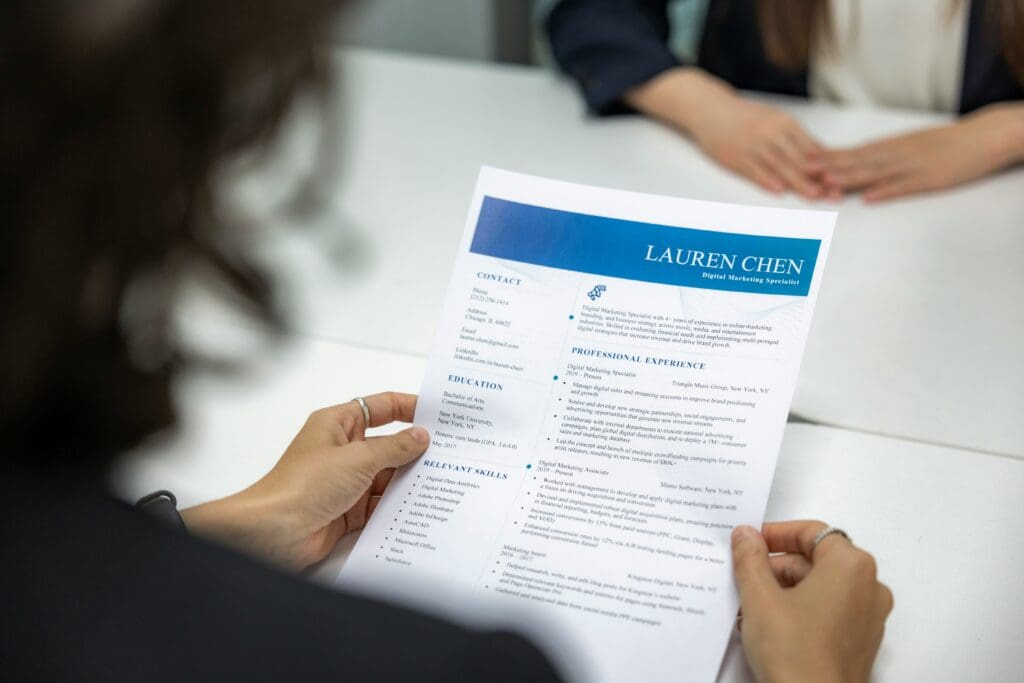Introduction on How to Write a Resume

A resume serves as a critical document in the job application process, acting as a concise summary of an individual’s education, skills, and experience. For students and recent graduates, crafting a well-structured resume is vital for making a positive impression on prospective employers. The primary purpose of this document is to present one’s qualifications clearly and effectively, allowing a candidate to showcase their expertise and fit for a specific role. A resume functions as a marketing tool, strategically designed to sell the applicant’s strengths and achievements.
Every student or recent graduate should recognize the necessity of having a resume. As they transition from academia to the professional world, a well-prepared resume can open doors to numerous job opportunities. Not only does it highlight an individual’s qualifications, but it also provides a platform to distinguish oneself from other candidates. By encapsulating relevant experiences and skills, a resume plays a fundamental role in the selection process and greatly influences a hiring manager’s initial perception.
The impact of a meticulously crafted resume cannot be overstated. A strong resume not only increases the likelihood of securing interviews but also reflects an applicant’s professionalism and attention to detail. For many candidates, particularly those with limited work experience, the resume is often the first impression made on potential employers. As such, investing time in developing a compelling resume is a crucial step for any student or recent graduate aiming to enter the competitive job market. Ultimately, a solid resume is essential for transforming academic accomplishments into career successes.
Understanding Different Types of Resumes

When crafting a resume, it is essential for students and recent graduates to understand the various types available, as each format serves a specific purpose and highlights different aspects of a candidate’s experience and qualifications. The three primary types of resumes are chronological, functional, and combination, each designed to accommodate diverse career trajectories and employment situations.
The chronological resume is perhaps the most commonly used format. It presents work experience in reverse chronological order, beginning with the most recent position. This format is advantageous for individuals with a solid work history in a particular field, as it allows employers to see a clear timeline of professional development and accomplishments. For students and recent graduates, this format can effectively showcase internships, part-time jobs, or relevant coursework, which can be organized chronologically to highlight growth and increments in skills.
In contrast, the functional resume emphasizes skills and competencies over employment history. This type is particularly useful for candidates who may have gaps in their work experience or are changing career paths. By focusing on specific abilities, such as communication or leadership, candidates can draw attention to their strengths rather than their chronological work history. For many students entering the job market or those with minimal experience, this type offers the flexibility to present qualifications that align with the job requirements.
Finally, the combination resume merges elements of both the chronological and functional formats. It typically begins with a skills summary followed by a chronological list of work experience. This format allows candidates to highlight pertinent skills while still providing a timeline of their professional journey. For students or recent graduates applying for internships, part-time positions, or entry-level jobs, the combination resume can effectively balance showcasing abilities with concrete experiences.
Essential Components of a Resume

Creating a compelling resume is paramount for students and recent graduates as they embark on their professional journeys. A well-structured resume should include several essential components that highlight one’s qualifications and readiness for the workforce.
The first critical element is the contact information, which should be prominently displayed at the top of the document. This includes the candidate’s full name, phone number, email address, and, optionally, a LinkedIn profile or personal website. Clear and accessible contact details ensure that potential employers can easily reach out for further engagement.
Secondly, a concise objective or summary statement helps to provide insight into the candidate’s career aspirations and key skills. This section should be tailored to the specific job role being applied for, encapsulating the individual’s goals and what they can bring to an organization.
Next, the education section is crucial, particularly for students and recent graduates. It should include the degree obtained, institutions attended, and graduation dates. Relevant coursework or academic honors may also be included to showcase areas of expertise.
The work experience segment follows, where candidates should list internships, part-time jobs, and volunteer roles. Each experience should detail their contributions and skills developed. This component should use action verbs to effectively convey achievements and responsibilities.
Besides work experience, candidates should incorporate a skills section that enumerates relevant abilities aligned with the target job. This may include both soft skills, such as communication and teamwork, and technical skills, such as proficiency in software tools.
Lastly, additional sections that highlight certifications, volunteer experiences, or extracurricular activities can further enrich the resume. These components illustrate a well-rounded candidate, showcasing interests and commitments outside of academics that enhance their employability.
How to Organize Your Resume Effectively

Creating an organized resume is crucial for students and recent graduates looking to make a strong impression in their job applications. The layout sets the tone for the entire document and influences how easily potential employers can sift through the information. Begin with a clear structure that is easy to follow. Standard sections such as contact information, objective statement, education, experience, skills, and relevant certifications should be prominently displayed. A clean and logical order will ensure that the most impactful information captures attention first.
When it comes to font selection, opt for professional and easily readable typefaces. Fonts such as Arial, Calibri, or Times New Roman in sizes 10-12 are advisable. This choice enhances readability and keeps the document looking polished. Avoid overly decorative fonts, which can distract the reader and detract from the content. Adequate spacing between sections is also essential; using white space effectively can make your resume feel less cluttered and more approachable.
Formatting plays a significant role in how your resume is perceived. Consistency is key; ensure that bullet points, headers, and text align uniformly throughout the document. Utilize bullet points for listing responsibilities and achievements, as this format allows for easy skimming. A common practice is to use bold or italics to emphasize specific areas, such as job titles or degrees earned, but it is vital to do so sparingly. Employing margins of at least 0.5 inches on all sides will provide ample space for the content, contributing to an overall clean appearance.
In summary, the effectiveness of a resume significantly hinges on its organization. Thoughtful layout, strategic font choices, and meticulous formatting can elevate the professionalism of your resume, ensuring that the desired information is easily accessible to hiring managers. Focusing on these elements can greatly enhance your chances of leaving a lasting impression with your application.
Tips for Tailoring Your Resume for Specific Jobs

Creating a tailored resume for each job application is paramount for students and recent graduates seeking to make a significant impression on potential employers. A generic resume often fails to capture the attention of hiring managers who typically sift through numerous applications, searching for candidates who best fit the role’s requirements. Therefore, customizing your resume becomes an essential step toward showcasing relevant skills and experiences that align with the specific job description.
Begin by carefully analyzing the job description. Identify the key qualifications and skills that the employer emphasizes. These may include specific technical proficiencies, soft skills, or even experiences that the company considers valuable. Once you have outlined these elements, strategically incorporate them into your resume. For instance, if a job listing highlights the need for project management skills, ensure that your experiences relating to this competency are prominently featured in your work history or skills section.
Additionally, the use of keywords extracted from the job description is crucial. Many companies utilize Applicant Tracking Systems (ATS) that scan resumes for these keywords before they even reach the hiring manager. Incorporate relevant industry-specific terms and commonly used jargon to boost your chances of passing through this digital filter. However, remember to do this naturally; keyword stuffing can lead to a disjointed resume and may detract from the quality of your presentation.
Another effective strategy is to pull examples from past experiences, internships, or volunteer positions that exhibit the skills prized by the employer. Quantify your achievements when possible, as numbers and specific outcomes can catch the reader’s attention and provide tangible evidence of your capabilities.
By following these tips for tailoring your resume, you enhance your prospects of securing an interview and ultimately landing a job that complements your academic background and career aspirations.
Common Mistakes to Avoid in Resume Writing

Creating an impactful resume is crucial for students and recent graduates seeking employment opportunities. However, there are several common mistakes that can undermine the effectiveness of a resume. One of the most prevalent pitfalls is the presence of typos and grammatical errors. These minor mistakes can lead potential employers to question the candidate’s attention to detail and professionalism. To avoid this, it is essential to proofread the resume multiple times or, better yet, have a peer review it for any overlooked errors.
Another frequent mistake is including misleading information. Candidates often exaggerate their skills or experiences in hopes of making a stronger impression. This strategy is counterproductive and can lead to significant repercussions if discovered. Honesty is vital; portraying an accurate representation of one’s qualifications is essential in gaining trust and credibility within the workforce. Instead of embellishing, candidates should focus on highlighting strengths and achievements authentically.
Poor formatting is also a significant mistake that many make when drafting their resume. A cluttered or overly complex layout can detract from the content of the document, making it difficult for hiring managers to extract relevant information quickly. To ensure clarity, a clean and organized format should be adopted, utilizing consistent fonts, spacing, and bullet points to enhance readability.
Finally, a lack of specificity in job descriptions is another drawback that commonly appears in resumes. Vague statements do little to convey a candidate’s actual abilities or experiences. Instead, applicants should strive to provide concrete examples that demonstrate their achievements and responsibilities clearly. Articulating past roles with measurable outcomes fosters a positive impression and showcases the value the candidate could bring to a potential employer.
When to Use a Resume and When to Avoid One

In the professional world, a resume serves as a crucial tool for job seekers, especially for students and recent graduates entering the workforce. Typically, a resume should be utilized during formal job applications and recruitment processes. Employers often request a resume to gain insight into an applicant’s qualifications, work experience, educational background, and skills. In instances such as career fairs and networking events, having a resume handy can significantly enhance one’s ability to make a positive impression on potential employers. A well-structured resume encapsulates your professional journey and helps facilitate meaningful discussions with recruiters.
However, there are circumstances where presenting a traditional resume might not be the most effective approach. For instance, in creative fields such as graphic design, writing, or the arts, a portfolio may be more beneficial. A portfolio allows candidates to showcase their work in a tangible and visually appealing manner, emphasizing the quality of their output over mere listings of experience and education. Similarly, digital platforms such as LinkedIn offer a modern alternative to conventional resumes. These online profiles can be easily updated and shared, providing a comprehensive overview of one’s professional endeavors while allowing for networking opportunities and direct engagement with industry professionals.
Additionally, consider cases where an employer explicitly indicates that a resume is not required. In such situations, it’s advisable to follow their preferred submission methods. Instead of sending a resume, you might opt to provide a brief cover letter or a detailed email outlining your qualifications and interest in the position. Understanding when to utilize a resume and when to adopt alternative methods can ensure that your application stands out and aligns with employer expectations, thus optimizing your chances of making a favorable impression.
The Purpose of a Resume Beyond Job Applications

While the most common use of a resume is for job applications, its significance extends far beyond that singular purpose. A resume serves as a multi-functional tool that can benefit students and recent graduates in various contexts. One notable application is in networking, where a well-crafted resume can facilitate connections with industry professionals. By sharing a resume at networking events or informational interviews, individuals can provide potential mentors or contacts with a concise overview of their skills, experiences, and aspirations, making a lasting impression.
Additionally, a resume plays a crucial role in internship applications. Many organizations require candidates to submit a resume even for entry-level positions or internships. Crafting a targeted resume allows students to highlight relevant coursework, projects, and skills that make them suitable for specific internship roles. This optimized presentation of qualifications can differentiate candidates in a competitive internship market, helping them gain valuable hands-on experience before entering the workforce.
Beyond internships and networking, resumes are increasingly important for academic opportunities. Students pursuing graduate studies may need to submit a resume as part of their application package, showcasing their academic achievements, research experiences, and extracurricular involvements. This resume acts as a comprehensive summary of one’s academic journey, demonstrating preparedness for advanced studies. Furthermore, resumes can be adapted for scholarships or fellowships, emphasizing relevant qualifications that align with the award criteria.
Therefore, a resume is not merely a document for securing employment; it is a versatile tool that can support career advancement in multiple avenues. Students and recent graduates are encouraged to view their resumes as dynamic representations of their evolving professional narratives, which can be tailored to fit various opportunities throughout their career path.
Final Touches: Reviewing and Polishing Your Resume

Once you have crafted the initial draft of your resume, the crucial phase of reviewing and polishing it begins. This final touch is essential to ensure that your resume makes a strong first impression. Start by editing for grammar and spelling errors, as any mistakes can detract from your professionalism. Utilize tools like grammar-checking software, but do not solely rely on them. It’s prudent to manually proofread the document as well, as automated tools may overlook nuances in language.
Seeking feedback from mentors or professionals in your field can provide invaluable insights. They can offer perspectives on how effectively your resume communicates your skills and experiences. Consider asking them to review your format, content, and overall presentation. Their experience can highlight areas you may have overlooked, ensuring that your resume stands out in a competitive job market.
Moreover, ensure that your resume is up-to-date. This means revisiting previously included experiences or accomplishments to verify their accuracy and relevance. Any new skills, internships, or volunteer experiences should be incorporated promptly. It’s essential that your resume reflects your current status accurately, as any discrepancies could raise concerns for potential employers.
Lastly, consider the aesthetic appeal of your resume. A well-organized layout, consistent font style, and appropriate use of white space can greatly impact readability. Ensure that your document is easy to skim, allowing hiring managers to quickly identify key qualifications and experiences. Taking the time to refine and enhance these elements in your resume will substantially improve your chances of landing an interview.
